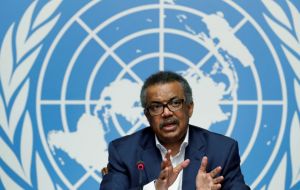MercoPress. South Atlantic News Agency
WHO-led initiative to reduce the use of alcohol by 10% by 2025
 Alcohol consumption contributes to more than 3 million deaths globally every year and over 5% of the global burden of disease and injury, according to WHO
Alcohol consumption contributes to more than 3 million deaths globally every year and over 5% of the global burden of disease and injury, according to WHO  “We are proud to introduce SAFER, a package of proven interventions to reduce the harms caused by alcohol” said Dr Adhanom Ghebreyesus, chief of WHO
“We are proud to introduce SAFER, a package of proven interventions to reduce the harms caused by alcohol” said Dr Adhanom Ghebreyesus, chief of WHO The World Health Organization (WHO) on Friday released SAFER, a new initiative and technical package outlining five high-impact strategies that can help governments reduce the harmful use of alcohol and related health, social and economic consequences.
SAFER is the newest WHO-led roadmap to support governments in taking practical steps to accelerate progress on health, beat noncommunicable diseases (NCDs) through addressing the harmful use of alcohol, and achieve development targets.
“We are proud to introduce SAFER – a package of proven interventions to reduce the harms caused by alcohol, and a new partnership to catalyze global action,” said Dr Tedros Adhanom Ghebreyesus, Director-General of the World Health Organization.
“We need governments to put in place effective alcohol control policy options and public policies to reduce the harmful use of alcohol.”
Health impact of alcohol use
Alcohol consumption contributes to more than 3 million deaths globally every year and over 5% of the global burden of disease and injury, according to the recently issued WHO Global Status Report (GSR) on Alcohol and Health 2018. It is also a major risk factor for NCDs, including cancers and cardiovascular diseases, communicable diseases such as TB and HIV/AIDS, violence, and injuries. Globally, alcohol consumption is the seventh leading risk factor for premature death and disability.
“We have seen too little progress since the endorsement of the ‘Global strategy to reduce the harmful use of alcohol’ by the World Health Assembly eight years ago. But SAFER brings new impetus for action,” said WHO Assistant Director-General Dr Svetlana Axelrod.
Dr Axelrod added: “We encourage countries to take action, monitor their progress, and protect alcohol policy development from interference by commercial interests. Support from civil society and donors is critical for success on alcohol control that contributes to reducing poverty, improving gender equality and improving public safety.”
SAFER: what it contains
SAFER provides five high-impact strategic actions that are prioritized for implementation to promote health and development: Strengthen restrictions on alcohol availability; Advance and enforce drink driving countermeasures; Facilitate access to screening, brief interventions, and treatment; Enforce bans or comprehensive restrictions on alcohol advertising, sponsorship, and promotion; Raise prices on alcohol through excise taxes and pricing policies.
Action is needed to reduce the burden of alcohol-related harm in low-, middle- and high-income countries.
According to the GSR, an estimated 2.3 billion people are current alcohol drinkers, but consumption varies across regions. More than a quarter (27%) of all 15 to 19-year-olds are current drinkers, with rates of current drinking highest among this age group in Europe (44%), followed by the Americas and the Western Pacific (both 38%).
Alcohol is consumed by more than half of the population in three WHO regions – the Americas, Europe and the Western Pacific. Current trends and projections point to an expected increase in global alcohol per capita consumption in the next 10 years, particularly in the South-East Asia and Western Pacific Regions and the Region of the Americas.
Almost all (95%) countries have alcohol excise taxes, but fewer than half use other price strategies such as banning below-cost selling or volume discounts. The majority of countries have some type of restriction on beer advertising, with total bans most common for television and radio but less common for the internet and social media.
Some countries have implemented and enforced policies to reduce alcohol use already. In the United States, states that increased the legal alcohol consumption age to 21 saw a 16% median decline in motor vehicle crashes. In Brazil, reducing the opening hours of bars from 24 hours a day to closure at 11 pm was associated with a 44% drop in homicides.




Top Comments
Disclaimer & comment rules-

Read all commentsDrunks vs. globalism.
Oct 01st, 2018 - 01:42 pm 0Lol.
Commenting for this story is now closed.
If you have a Facebook account, become a fan and comment on our Facebook Page!